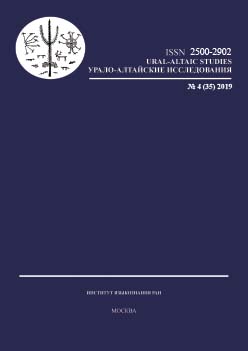Bemerkungen zum Bestand der dentalen Spiranten der U/FU/Ug Grundsprache
Remarks on the stock of dental fricatives in Proto-Uralic/Proto-Finno-Ugric/Proto-Ugric
Author(s): László HontiSubject(s): Phonetics / Phonology, Historical Linguistics, Finno-Ugrian studies
Published by: Институт языкознания Российской академии наук
Keywords: Uralic languages; dental fricatives; historical phonetics;
Summary/Abstract: Statements on etymology and phonological development in the book by András Róna-Tas and Árpád Berta (RTA 2011a, RTA 2011b) encouraged the author to write about certain consonants in the Proto- Uralian/Proto-Finno-Ugric language again in his recent book (Honti 2017), but the main topic of the volume did not make it possible for him to discuss all the important details, and some new answers have been elaborated since then. This paper focuses on the following consonants: *δ, *δ́, *ϑ, *ϑ́, *ʌ, *ʌ́, *s, *š. The author refutes the presence of the *δ and *δ́ sounds in the proto-language, but suggests accepting the early existence of the *ʌ, *ʌ́ and *ϑ sounds. The author also presents in what circumstances the rare sequels of the non-palatal sibilants in present-day Ugrian languages were formed: U/FU *s × *š > early Ug *s > late Ug *ϑ > Ostyak s, Vogul s and Hungarian sz, instead of the general and regular Ostyak l, ʌ, t, j, 0-, Vogul t and Hungarian 0 correspondences. The author argues that the Proto-Ugrian *ϑ became 0 in Hungarian via *h.
Journal: Урало-алтайские исследования
- Issue Year: 2019
- Issue No: 04 (35)
- Page Range: 119-135
- Page Count: 17
- Language: German

